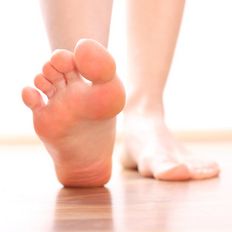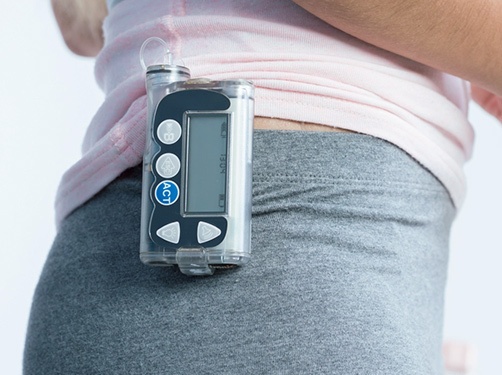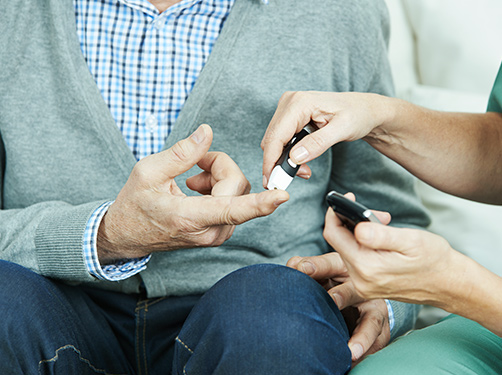Diabetic foot
Scientific support: Dr. Gidon Bönhof
The terms diabetic foot syndrome or diabetic foot encompass all diabetes-related pathological changes to the foot of a person that cause wounds or tissue damage. Depending on the patient, diabetic foot syndrome can take on many different forms. The common characteristic in all forms is the presence of a wound.
Elevated blood sugar levels over the course of many years can damage the nerves and blood circulation in the foot. This causes people with diabetes to have difficulty perceiving wounds on their feet, and the body has a more of a problem healing the wounds by itself. Wounds can become very large and deep if not treated in time. In the worst cases, the wounds can cause tissue damage so severe that the toes or foot must be amputated.

How can you prevent diabetic foot syndrome?
1. Attend regular medical check-ups!
2. Care for and examine your feet on a daily basis using these steps:
- Look at your feet from all sides. Do you see pressure sores, misalignments, or callosities? Do you have yellow/brown colored or brittle nails as signs of nail fungus? Are there small lesions or wounds?
- Wash your feet using a lukewarm foot bath (approx. 37-38 degrees Celsius, check the temperature using your hands!) for 3-5 minutes. Afterwards, make sure you dry your feet thoroughly, especially between the toes. If you have wounds on your feet, then disinfect only and do not wash.
- Using a file, file your nails straight and not rounded to ensure that they do not grow inward or curl so easily. Do not use nail scissors, clippers, or pliers.
- Remove hard skin using a pumice stone. Do not use files or razor blades.
- Regularly apply cream to dry feet. Use a moisturizing cream or foot foam containing urea (5-10 %). Do not use greasy ointments, oils, zinc pastes, or powder.
- Change socks or stockings on a daily basis. Only use socks or stockings with a high cotton content.
Good to know:
There is no such thing as harmless foot wounds or injuries for people with diabetes. Always seek medical advice if a wound does not heal rapidly!
Good to know:
Use a mirror to check the soles of your feet!
3. Use the following rules when choosing shoes:
- Select wide and closed shoes with a flat heel. The uppers should be soft and the soles flexible.
- Check for seams that rub on the feet on the inside of the shoes.
- Don’t buy shoes in the afternoon or evening because your feet swell throughout the course of the day. When trying on shoes for the first time, there should be no sensation of rubbing or discomfort. There should be 1 cm of space in front of the toes.
- Wear new shoes in carefully and begin by alternating between new shoes and an existing pair until you are sure that your feet are used to the new shoes.
4. Learn to appreciate your feet!
Most people are not aware of how much feet have to do on a daily basis. In contrast to the hands, that we consciously control and can always see, we tend not to be aware of our feet unless we have problems walking. Also, the feet smell bad or get dirty more easily.
Nevertheless, you should be aware that your feet carry you your entire life and your full weight is borne by both your feet. These structures consisting of bone, tendons, and muscle do a lot for you when standing and walking without you having to consciously control each step. Learn to appreciate your feet!
Wounds on the feet are caused by pressure stress coming from the inside of the foot or externally. Internal pressure stress can be the result of foot bone misalignment. External pressure stress can be caused by pointed objects, e.g., a stone in your shoe. Repeated stress to a certain point, e.g., caused by the rubbing of a seam inside the shoe when walking, causes external pressure stress. Three reasons why the wounds are not identified and have problems healing:
1. There is nerve function damage:
The feet and the brain are connected to one another via nerve pathways. The nerve pathways work in a similar way to electrical cables. The skin contains many sensors to detect sensation, such as touch, temperature, and pain and transmit these to the brain. The brain also sends signals to the muscles via the nerves. Both can play a role in the onset of diabetic foot syndrome.
In many cases, people with diabetes have a reduced ability to sense touch and or pain in their feet. This means the nerves do not adequately report the development of a wound on the foot to the brain. This causes the body to lose its awareness of the existence of wounds. Patients stop taking care of the wound and continue to subject it to pressure causing it to get bigger and deeper.
The brain controls the muscles and sweat glands via the nerve pathways. For example, in healthy people, the muscles automatically ensure a correct gait and joint positioning. In contrast, in people with diabetic nerve damage, the automatic control no longer functions correctly. This leads to malpositioning when walking and misalignment of the bones. An example of this is claw toes - when the tips of the toes do not point forward but rather bend downwards. This causes the tip of the toes to be subjected to much more pressure when walking. This leads to pressure sores and injuries on the feet.
2. Impaired blood circulation:
Healthy tissue depends on a sufficient supply of oxygen and nutrients from the blood. The muscles are also supplied by the blood. Many people with diabetes have weakened blood vessels. The blood vessels are hardened, injured, inflamed, narrowed, or even completely blocked. When the supply of oxygen and nutrients is inadequate, the muscles become exhausted quicker during exertion. If someone has muscle pain in their legs after walking for a few hundred meters, this may point to arterial problems (“smoker’s leg”).
How well a wound heals always depends heavily on the blood supply. During the wound healing process, the wound has a good blood supply and receives essential nutrients. If the blood supply is poor, then the wound will have difficulty healing or not heal at all. The body is also less capable of providing protection against bacteria and an infection is more likely.
3. There are changes to the skin:
Due to impaired nerve function, the sweat glands of people with diabetes can no longer be controlled, and the skin loses moisture. This causes the skin on the feet to lose elasticity and become more susceptible to tears and injuries. For this reason, good foot care is crucial for people with diabetes.
In most cases, diabetic foot manifests itself via the development of poorly healing wounds. These wounds commonly develop on the front part of the foot in the region of the ball of the foot or the toes. Wounds can also develop on the heel. The skin is often dry, chapped, and with a large amount of hard skin.
The wounds get infected, become even more reddened and have a firm yellow coating. Other wounds weep profusely and soften the surrounding skin. In the most severe cases, the tissue dies. The wounds can quickly become deep, making the tendon, or even the bones, visible in the wound or directly palpable. In these cases, the risk of infection is very high.
A different, but nevertheless very dangerous form, is known as Charcot foot. This causes foot bone instability, makes the bone easy to break, causing lifelong bone deformation. Examples of the signs of Charcot foot include a suddenly swollen and potentially hyperthermic foot with no pain.
A number of factors can promote the onset of diabetic foot syndrome:
- Nerve damage with loss of sensitivity in the feet
- Narrowed and damaged blood vessels in the legs
- Many years of elevated blood sugar levels
- Poor joint mobility
- Footwear that is unsuitable or too tight
- Foot malposition
- Calluses, corns, ingrown toenails
- Walking barefoot
- Inadequate foot care or lack of hygiene
- Smoking or alcohol dependency
- Being severely overweight
- Impaired sight
Doctors examine the feet, socks, and stockings of people with type 2 diabetes at least once a year. Examination of people with type 1 diabetes begin after they have had diabetes for five years or when they turn 11. People with diabetes who already have nerve damage are examined every six months. People with diabetes who already have wounds on their feet are examined every three months. The doctors also examine the health of the skin and disorders affecting the nerves and blood vessels.
The doctor begins the examination with a detailed conversation regarding preexisting conditions, accompanying diseases, and ongoing medication. They ask if the patient’s feet feel numb or painful. They doctor then proceeds to take a closer look at the feet. For example, they will assess the skin, muscles, joints, and mobility. Using a firm nylon thread, the doctor tests the sensitivity of the foot by pressing a firm nylon thread against the foot. An oscillating tuning fork is also placed on the feet to determine vibration sensitivity.
The pulse on the ankle and foot is checked. Vascular problems are suspected when the pulse is not strong and clear. The doctor will then order further examinations. For example, they will examine to what extent the blood pressure differs in the arms and legs. Ultrasound can be used to check the blood vessels throughout the leg for narrowed vascular segments as well as determine blood flow velocity. In some cases, further examinations, e.g., ultrasound or MRI, may be necessary.
Doctors treat diabetic foot syndrome depending on the underlying cause and how severe the case is.
If no pressure sores, malposition, nerve damage, or vascular diseases are identified, preventive measures are discussed. Foot malposition is treated using special insoles or orthopedic shoes. Special insoles or protective diabetic shoes may also be prescribed if the patient has a reduced sensitivity to touch. Protective diabetic shoes should be used if there has previously been a poorly healing wound on the foot. Foot malposition causing pressure sores is sometimes – after careful consideration – treated using surgery.
The wounds are cleaned, callouses and infection tissue removed, then bandaged. The diabetes team uses special wound dressings. In some cases, an operation to remove dead tissue is required. Special shoes must also be worn alongside the bandaging. In many cases, the wound dressing and bandaging need to be replaced three times per week and the wounds disinfected. If the patient is unable to change the bandaging themselves, a home care service may have to be organized.
In the event of infection, and after a swab is taken from the infected wound, a suitable course of antibiotics will be prescribed. If there are signs of potential bone inflammation, this will be investigated using an x-ray examination and potentially a magnetic resonance examination. In these cases, those affected cannot walk without using special pressure relieving measures until the wound has healed. Some cases may even require bed-rest to allow the wound to heal.
The diabetes treatment team will also aim to optimally control the blood sugar levels and treat any underlying diseases, such as nerve damage and vascular problems. For example, the treating physician will prescribe blood-thinning medication or order vascular surgery.
Find out more about the treatment of nerve damage here!
Find out more about the treatment of vascular problems here!
If these methods are no longer efficient to treat the underlying disease and adequately complete the wound healing process, new supplementary treatment approaches can be considered. There is evidence of a speedier wound healing process when cold-plasma therapy is applied and a reduction in the rate of major amputations when special oxygen therapy (hyperbaric oxygen therapy (HBOT)) is used. However, these measures cannot replace consistent wound care and pressure relief.
In cases of especially severe wounds that won’t heal, it may be necessary to remove part of the foot or the entire foot. Before an amputation is carried out, it is essential to obtain a second opinion from a different department or another treatment center! In accordance with § 27b SGB V, statutory health insurance patients have the right to obtain an independent second medical opinion.
Podiatrists are state-certified specialists for medical foot care. Medical foot care is different from cosmetic foot care. A podiatrist helps with regular and careful foot care and is well-versed in cases associated with diabetes. This can help prevent the onset of diabetic foot syndrome.
If a physician identifies damage to the feet, nerves, or blood vessels during an examination, then they will prescribe a course of medical foot care at a specialist practice for podiatry. The risk of pressure sores and infection is reduced by treating the skin and nails.
Good to know:
Medical foot care from a podiatrist is different to cosmetic foot treatments.
In Germany, approximately 2 to 10 people with diabetes suffer from diabetic foot syndrome. This represents 160,000 to 800,00 people in Germany. Every year, up to 480,000 people with diabetes develop diabetic foot syndrome. Every 3rd to 5th person with diabetes will unfortunately suffer at least once from a poorly healing wound during their lifetime.
Sources:
Ärztliches Zentrum für Qualität in der Medizin: Diabetes - Schäden an den Füßen. (Letzter Abruf: 04.10.2022)
American Diabetes Association: Standards of Medical Care in Diabetes - 2019. In: Diabetes Care, 2019, 42: S1-S193
Arbeitsgemeinschaft Fuß der Deutschen Diabetes Gesellschaft: Podologische Therapie beim Diabetischen Fuß-Syndrom (DFS). 2018
Deutsche Diabetes Gesellschaft et al.: Deutscher Gesundheitsbericht Diabetes 2019. Kirchheim Verlag, Mainz, 2019
Gemeinsamer Bundesausschuss: Beschluss über eine Änderung der Richtlinie zum Zweitmeinungsverfahren: Aufnahme des Eingriffs Amputationen beim Diabetischen Fußsyndrom in den Besonderen Teil sowie weitere Änderung im Allgemeinen Teil der Richtlinie. 2020
Gemeinsamer Bundesausschuss: Beschluss des Gemeinsamen Bundesausschusses über eine Änderung der Richtlinie Methoden vertragsärztliche Versorgung: Hyperbare Sauerstofftherapie bei diabetischem Fußsyndrom. 2017
Morbach, S. et al.: Diabetisches Fußsyndrom. In: Diabetologie, 2021, 16: S362-S372
As of: 04.10.2022






